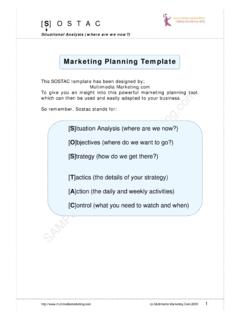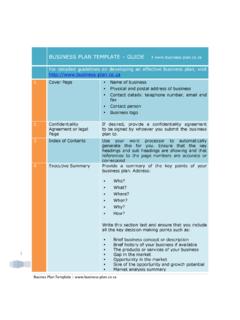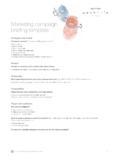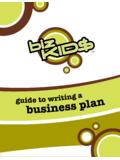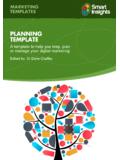Transcription of WORKSHEET 4 Marketing Plan Template - ALA Editions
1 WORKSHEET 4. Marketing plan Template Separate Marketing plans should be developed for each product/service to be promoted or for each product/service family to be promoted. The Marketing plan can be a few pages, with each section containing a couple of paragraphs, or each section can have a few pages. TABLE OF CONTENTS. This section is recommended to ensure ease of review. EXECUTIVE SUMMARY. This section presents a summary of the proposed plan for quick skimming by management. SECTION I. Introduction (See chapter 4.). Describe the existing or envisioned service in detail and explain how it fits into the market: 1. What are the benefits of the service? a. What is the core benefit being offered? (What is the customer really seeking? What need is the service really satisfying?). _____. _____. _____. b. What benefits accrue to the community/campus when members of the target market use this service?
2 _____. _____. _____. 2. How are the characteristics of the service managed? a. What tangible item(s) does the customer see, feel, hear, touch, or receive as a result of receiving this service? _____. _____. _____. b. What library personnel does the customer come in contact with to obtain this service? What technology does the staff person use to provide this service? How does the ser- vice function? _____. _____. _____. From Blueprint for Your Library Marketing plan , by Patricia H. Fisher and Marseille M. Pride (Chicago: American Library Association, 2006). WORKSHEET 4. Marketing plan Template (cont.). c. What steps are being taken to decrease the variability and ensure consistent quality when this service is delivered to the customer? _____. _____. _____. d. What measures are being taken to balance supply and demand for the service? _____. _____. _____. e. What do customers have to do or know to have the best experience in seeking the benefits of the service?
3 _____. _____. _____. 3. What resources are needed to deliver the service? a. What existing or additional hardware, software, electronic databases, print sources, etc., will be used or must be purchased to deliver the service? What staff reallocations or hir- ing is required? _____. _____. _____. b. What partnerships with other organizations should be forged to supplement or complement capabilities? (Identify areas to be complemented or supplemented here. Identify potential partners to target and strategies in Sections VI and VII, below.). _____. _____. _____. 4. Where does the service fall in the service family hierarchy? _____. _____. _____. 5. What stage of the life cycle is the service in? _____. _____. _____. From Blueprint for Your Library Marketing plan , by Patricia H. Fisher and Marseille M. Pride (Chicago: American Library 2. Association, 2006). WORKSHEET 4. Marketing plan Template (cont.)
4 6. What is the service description for your service? _____. _____. _____. SECTION II. Target Market Description (See chapter 5.). (Information about the characteristics of your target market may be obtained from a strate- gic plan or from other worksheets.). Basic Assumptions (Record basic assumptions and/or indicate notations used to show that answers to questions 1 10 are assumptions, , with *.). _____. _____. _____. 1. What are the demographics of the target market? What is the size (how many people in total)? _____. Age range: _____ Gender: Male _____ Female _____ Total _____. Ethnicities: _____. Languages spoken: _____. Income range: _____. Education level: _____. Other(s): _____. What are the significant demographic trends? _____. _____. 2. What are the geographic demographics that have Marketing implications for your product/service? What is the area's population? _____. What is the population growth pattern (stable, negative, positive)?
5 _____. How many public and private K 12 schools are in the community? _____. What section of the country is the library and its target markets located (North, South, East, West)?_____. What is the population density (urban, suburban, rural)? _____. What type of media outlets are available (local, regional, national)? _____. Other(s): _____. From Blueprint for Your Library Marketing plan , by Patricia H. Fisher and Marseille M. Pride (Chicago: American Library 3. Association, 2006). WORKSHEET 4. Marketing plan Template (cont.). 3. How do members of this target market use the library (behavioral data)? (Categories can overlap. Estimates could exceed 100% of total market size.). How many (or what percentage): Have library cards? _____. Regularly use the library to borrow materials? _____. Occasionally use the library to borrow materials? _____. Formerly used the library to borrow materials?
6 _____. Would be first-time library users? _____. Use materials in the library? _____. Use reference services? In-library: _____. Telephone: _____. Online: _____. Attend library programs?_____. May have never used the library?_____. 4. On what occasions (days of weeks, specific months, holidays) would members of this target market most likely use the service? _____. _____. 5. What are the significant library usage trends? _____. _____. 6. What are the five most prominent lifestyles within your target market (psychographics)? (Look up by ZIP code in You Are Where You Live ). Lifestyle 1: _____. Narrative description: _____. _____. Lifestyle 2: _____. Narrative description: _____. _____. Lifestyle 3: _____. Narrative description: _____. _____. From Blueprint for Your Library Marketing plan , by Patricia H. Fisher and Marseille M. Pride (Chicago: American Library 4. Association, 2006). WORKSHEET 4.
7 Marketing plan Template (cont.). Lifestyle 4: _____. Narrative description: _____. _____. Lifestyle 5: _____. Narrative description: _____. _____. 7. What are the significant lifestyle trends? _____. _____. _____. 8. What benefits of this service are valued most by members of this target market? What needs and wants are satisfied by the benefits of this service? _____. _____. _____. 9. Why is there a demand for this service in the target market? How much demand is anticipated? _____. _____. _____. 10. What are the media habits of the target market? What type (or specific outlet). of medium is viewed ( , conservative radio talk show; CNN on cable TV)? Medium Hours/Week Type (category). Television _____ _____. Radio _____ _____. Magazines _____ _____. Newspapers _____ _____. SECTION III. Current Market Situation (See chapter 6.). 1. Describe the competition. What alternatives can members of the target market obtain to satisfy their needs or wants?
8 Or, what alternatives do members of the target have for spending their time? Desire Alternative Assessment of competing alternative _____ _____. Generic Alternative Assessment of competing alternative _____ _____. From Blueprint for Your Library Marketing plan , by Patricia H. Fisher and Marseille M. Pride (Chicago: American Library 5. Association, 2006). WORKSHEET 4. Marketing plan Template (cont.). Form Alternative Assessment of competing alternative _____ _____. Enterprise Alternative Assessment of competing alternative _____ _____. 2. Describe the library's current position in the mind of members of your target market by answering one or more of the following questions: a. How do members of the target market currently perceive your library? _____. _____. _____. b. What is your library's image compared to the image of a provider of a competing alternative? _____. _____. _____. c. What is your library's image compared to the image of an ideal provider of a competing service?
9 _____. _____. _____. d. What is your current positioning statement for the service? _____. _____. _____. 3. Describe the place (library's outlets) where the service can be obtained: (In narrative format, provide answers to applicable questions below.). a. How many physical outlets (main library, branches, bookmobiles, kiosks)? _____. _____. _____. b. What are the dimensions of the physical outlets (square footage)? _____. _____. _____. c. What are the virtual outlets (telephone, website)? _____. _____. _____. From Blueprint for Your Library Marketing plan , by Patricia H. Fisher and Marseille M. Pride (Chicago: American Library 6. Association, 2006). WORKSHEET 4. Marketing plan Template (cont.). d. Are there barriers to use associated with your service? _____. _____. _____. e. Describe the atmospherics of the physical or virtual outlet (look, feel of exterior and interior). _____. _____.
10 _____. f. How many librarians, support staff, and volunteers are available to deliver the service? _____. _____. _____. g. What level of customer service do you provide? _____. _____. _____. h. What special training has been given to staff to deliver the service? _____. _____. _____. i. What customer service training has been given to staff? _____. _____. _____. j. Will you need to forge partnerships to make this service available? _____. _____. _____. 4. What nonmonetary or monetary price does the customer have to pay to obtain your service? What is burdensome about obtaining your service? a. Time (waiting time, frustration). b. Convenience c. Transportation costs: public transportation, automobile costs, gas, parking d. Fees e. Other From Blueprint for Your Library Marketing plan , by Patricia H. Fisher and Marseille M. Pride (Chicago: American Library 7. Association, 2006). WORKSHEET 4.

